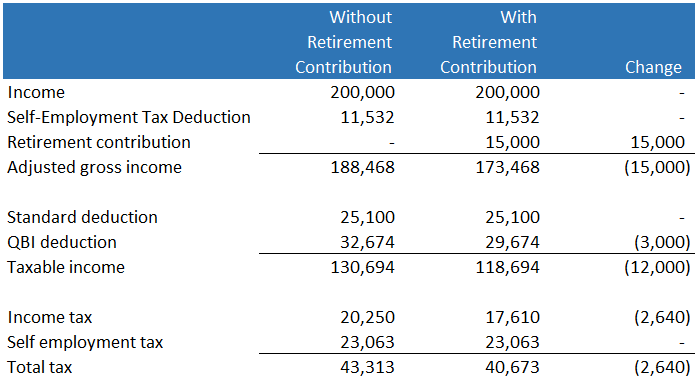If you own a small business, then you might be familiar with the Qualified Business Income (QBI) deduction that’s available to owners of pass-through entities such as sole proprietorships, LLCs, S-Corps, or partnerships.
The QBI deduction rules allow the business owner to deduct up to 20% of the lesser of a) your net business profits or b) your total taxable income prior to taking the QBI deduction.
For example, if you are married and in 2021 your only income was $200,000 of self-employed business profits, then your taxable income (before any QBI deduction) comes out to $163,368 ($200,000 – $11,532 of self-employed payroll tax – $25,100 standard deduction). Then you need to fill out IRS Form 8995, where you compute the QBI deduction based on 20% of the smaller of a) $200,000 or b) $163,368, which in this case comes out to $32,674 (20% x $163,368). This leaves you with $130,694 of taxable income and puts you squarely in the 22% marginal tax bracket.
If you (or your spouse) has income from other sources, such as wages, then the calculation will shift slightly, but remains functionally the same.
QBI deduction phase outs
The QBI deduction phases out at higher income levels. For 2022, those limits are $220,050 for single filers and $440,100 for married filers. If you are beyond those limits, the rules for calculating QBI deductions depend on a variety of factors including the type of business and the level of wages paid by the business. It’s best to consult a CPA if you find yourself in this situation.
Retirement contributions
While generally a solid benefit for small business owners, the QBI deduction can actually reduce the value of your pre-tax retirement contributions. For an example, let’s use the same amounts as before: married with $200,000 of business income. Now assume that you make a pre-tax retirement contribution of $15,000. Let’s look at a side-by-side comparison:

As you can see, the retirement contribution reduces your adjusted gross income by $15,000, but you also lose $3,000 of your QBI deduction. This leaves you with a net deduction of $12,000, not the full $15,000 you were expecting. And this only shaves $2,640 off of your tax bill ($12,000 x 22%).
So even though you are in the 22% marginal bracket, your effective tax savings rate isn’t 22%, but rather 17.6% ($2,640 ÷ $15,000). This means that you didn’t get the full tax value for your retirement contribution. And when you take the money out in retirement, you still owe tax on the full $15,000.
In this way, the QBI deduction disincentivizes small business owners to make pre-tax retirement contributions. For taxpayers in the 10%, 12%, 22%, and 24% marginal tax brackets, it might make more sense to use a Roth contribution instead of pre-tax (at least up to limits for elective deferrals). Your current tax bill will be higher, but you will at least get the full tax protection for the contribution.
But if you find yourself in the 32% marginal bracket or above, then make sure to discuss your retirement savings approach with your CPA or financial planner. It all likelihood, you’ll need to run a forward looking tax projection to determine the best solution for your tax situation. This is a critical component of tax planning that can help you make an educated decision.

